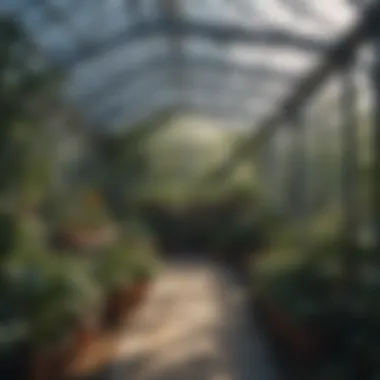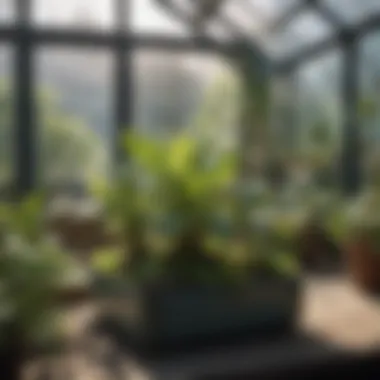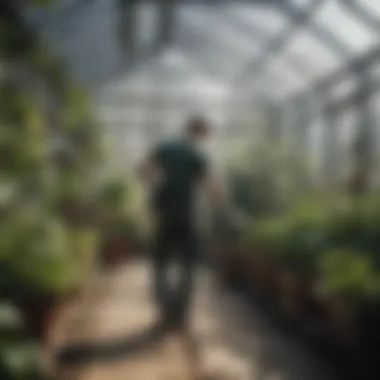Building a Small Greenhouse at Home: A Comprehensive Guide


Intro
Creating a small greenhouse at home is an exciting venture for many gardening enthusiasts. It allows for year-round gardening regardless of climate conditions. Understanding how to build one efficiently can transform not only your gardening capabilities but also enrich your living space. This guide will delve into the key aspects of constructing a greenhouse tailored to your unique needs. We will explore planning, design elements, materials, and maintenance practices that are vital for sustaining a successful growing environment.
Design Inspiration
Current Trends in Greenhouse Design
The design of your greenhouse plays a pivotal role in its functionality and aesthetic. Today, many homeowners opt for modern, minimalistic designs that integrate seamlessly with their garden spaces. Popular trends include:
- Geometric Shapes: Many modern greenhouses feature angular designs. These shapes allow for optimal sunlight exposure.
- Natural Materials: Wood is becoming a favored choice among builders. It offers durability and blends well with the outdoor environment.
- Retractable Roofs: Some greenhouses now include retractable roofs to improve ventilation and allow for varied climate management.
Innovative designs not only elevate the visual appeal of your garden but also enhance the performance of your plants. Understanding current trends allows you to make informed choices.
Color Schemes and Palette Ideas
Color plays an important role in both function and aesthetics. When choosing a color scheme for your greenhouse, consider:
- Neutral Tones: White or light gray materials can reflect sunlight, keeping the greenhouse cooler during hot months.
- Earthy Colors: Greens and browns can harmonize with the natural landscape, making your greenhouse less intrusive.
- Accent Colors: Bright colors for the greenhouse framing can add a touch of personality without overwhelming the space.
Using the right color palette can also affect your psychological comfort while working in the greenhouse.
Gardening Techniques
Plant Selection and Care
Selecting the right plants for your greenhouse is critical for success. Some plants thrive in controlled environments:
- Herbs: Basil, parsley, and mint grow well in greenhouses.
- Vegetables: Tomatoes and peppers are excellent choices.
- Flowers: Many annuals can flourish, providing beauty alongside your edible plants.
Understanding the specific needs for watering, light, and compost can lead to a bountiful harvest. Proper care techniques are essential for maintaining plant health.
Indoor vs. Outdoor Gardening
Gardening can take place indoors or outdoors with specific considerations:
- Indoor Gardening: Greenhouses can create a microclimate suitable for delicate plants. Considerations like humidity levels, light sources, and temperature regulation are essential when gardening indoors.
- Outdoor Gardening: While outdoor gardening exposes plants to natural conditions, it may invite pests and harsher weather. In this case, greenhouses provide an added layer of protection while still allowing the benefits of natural sunlight.
Choosing between indoor and outdoor options in your greenhouse depends on your gardening goals and local climate.
"A greenhouse extends the growing season and allows for a wider variety of plants to thrive, making it a wise investment for dedicated gardeners."
By thoughtfully addressing each element of greenhouse construction, from design inspiration to practical gardening techniques, one can create an efficient and personalized growing environment. With planning and insight, building a small greenhouse at home becomes a fulfilling project for any gardening enthusiast.
Understanding Greenhouse Basics
Understanding the fundamentals of greenhouses is crucial for anyone looking to create a productive gardening environment at home. A greenhouse is not just a structure; it represents a controlled ecosystem that facilitates the growth of plants by providing an optimized environment. Identifying the key elements and benefits associated with greenhouses will clarify their significance in the realm of modern gardening.
What is a Greenhouse?
A greenhouse is essentially a sheltered structure designed to cultivate plants by harnessing solar energy. Constructors use various materials to form a frame, often combining wood or metal with transparent coverings such as glass or plastic that allow sunlight to penetrate. The design may vary in size and shape, ranging from modest, small units to large, elaborate installations meant for commercial purposes. The primary function of any greenhouse is to provide an environment insulated from external elements like wind, rain, and pests.
The temperature inside a greenhouse generally remains warmer than the outdoor atmosphere during cooler months. This unique feature can extend the growing season and enable individuals to cultivate seasonal crops throughout the year. By controlling elements like humidity and temperature through ventilation systems and heating options, gardeners can create ideal conditions for a variety of plants.
Benefits of Using a Greenhouse
Utilizing a greenhouse for gardening comes with a plethora of advantages:
- Extended Growing Seasons: A greenhouse allows gardeners to start seeds earlier in the spring and continue growing into late fall or even winter. This is particularly useful for regions with shorter growing seasons.
- Protection from the Elements: Plants are shielded from harsh weather conditions such as excessive rain, strong winds, and frost, which can cause damage.
- Pest and Disease Control: Enclosed spaces limit the exposure to pests and diseases. This helps in reducing reliance on chemicals, promoting a more organic approach to gardening.
- Controlled Environment: Gardeners can manipulate temperature, humidity, and light levels, tailoring the growing conditions to meet the needs of various plants.
- Diverse Plant Cultivation: With the ability to manage environmental factors, a wider range of plants can be grown, including tropical species that require specific conditions not otherwise found outdoors.
"A greenhouse not only facilitates efficient plant growth but also enhances the overall gardening experience by allowing for experimentation and creativity in plant selection."
The strategic advantages provided by a greenhouse can significantly elevate one's gardening endeavors, making it an indispensable tool for many gardening enthusiasts. Understanding these basics sets the stage for later sections that delve deeper into choosing the correct type of greenhouse, planning, and ultimately constructing your own.
Types of Greenhouses
The type of greenhouse you choose can greatly affect your gardening success. Understanding the various options available will help you make informed decisions aligned with your gardening goals. Each type has its benefits and considerations, so let's explore them in detail.
Freestanding vs. Attached Greenhouses
Freestanding greenhouses stand alone in your yard and offer maximum flexibility in placement and size. This type allows for better access to sunlight from all directions, which is particularly beneficial during the winter months when the sun is lower in the sky. Additionally, a freestanding greenhouse provides ample space for a variety of plants, creating an optimal environment conducive to growth.
On the other hand, attached greenhouses, which are built onto an existing structure, like your home or garage, have their own advantages. They can utilize the warmth from the attached building, potentially reducing heating costs during colder seasons. This type often requires less land area and can be more economical since shared walls can lead to savings on materials.
When deciding between the two, consider your available space, budget, and gardening plans. If you have room for expansion and want a diverse planting area, a freestanding greenhouse might be the right choice. Conversely, if space is limited, an attached option can create a cozy gardening nook without taking up much land.
Mini Greenhouses for Small Spaces
If space is at a premium, mini greenhouses can be an excellent solution. These compact structures fit in small yards, patios, or even balconies, making them accessible to urban gardeners or those with limited outdoor space. Mini greenhouses often come in a variety of designs, including portable options that are easy to move.


From a functional perspective, mini greenhouses still provide similar benefits to larger ones, such as protecting plants from extreme weather and pests. They also create a controlled environment that can be tailored to specific plants. For home gardeners looking to grow herbs or a few vegetables, a mini greenhouse can offer a perfect balance of efficiency and simplicity.
Planning Your Greenhouse
Planning your greenhouse is pivotal to creating a successful growing environment. This phase sets the groundwork for all subsequent decisions, from structure to functionality. Careful consideration during planning leads to an efficient greenhouse that supports your gardening ambitions.
Choosing the Right Location
Selecting an appropriate location for your greenhouse is essential. The site should receive maximum sunlight throughout the day. Ideally, southern exposure helps in absorbing warmth and light. Additionally, avoid areas with heavy tree cover, as shade can impede plant growth.
The ground must also be level to ensure stable construction. It is wise to consider accessibility too. Ensure you can access water, electricity, and pathways for ease during maintenance. Some other aspects to look at include:
- Proximity to home: This allows for easy monitoring and care of your plants.
- Wind protection: Areas shielded by hedges or nearby structures prevent wind damage and unwanted cool temperatures inside the greenhouse.
- Soil quality: If planning to grow in pots or beds outside, ensure the surrounding soil is not contaminated.
Sizing Your Greenhouse
Determining the correct size for your greenhouse can impact its efficiency. Think about your gardening goals—what plants you want to cultivate, the quantity, and how much space those plants require. A larger greenhouse may accommodate a wider variety of plants but will also need more resources for heating and cooling.
Also, consider potential future needs. If you plan to expand your gardening efforts, opt for a size that allows for growth. Key factors to consider in sizing are:
- Available Space: Take a measurement of the area you have for the greenhouse. It is important to utilize that space well without overcrowding.
- Plant Requirements: Different plants have diverse space requirements. Ensure you research the plants you want to grow to plan appropriately.
- Access and Movement: Leave space for walking paths inside to facilitate care and harvesting without damaging crops.
By thoughtfully choosing the location and sizing of your greenhouse, you can establish an environment that promotes healthy plant growth and ensures ease of use.
Materials for Greenhouse Construction
Constructing a greenhouse involves careful selection of materials. This choice greatly influences the greenhouse’s durability, efficiency, and overall functionality. It is crucial to understand how materials contribute to the greenhouse environment, impacting not just the structure's longevity but also the health of the plants inside. Different materials also provide various benefits and considerations that can enhance the gardening experience.
Framework Materials
The framework of a greenhouse serves as its backbone, supporting the entire structure. Common materials include wood, aluminum, PVC, and galvanized steel. Each material has its traits.
- Wood: Offers a natural aesthetic but requires treatment to resist rot and pests. It can be relatively easy to work with for DIY enthusiasts.
- Aluminum: Lightweight and resistant to rust, aluminum is often preferred for modern greenhouses. It is also low maintenance, so it does not require frequent upkeep.
- PVC: This is a budget-friendly option that is lightweight and easy to assemble. However, it may not be as durable as metal frames.
- Galvanized Steel: Known for its strength and longevity, it is an excellent choice for those seeking a robust structure. However, it tends to be heavier and may require more effort during installation.
Each framework material has advantages and restrictions that should be weighed against your specific needs and climate. Choosing the right framework material is essential for ensuring the greenhouse withstands environmental stresses.
Glazing Options
Glazing refers to the material that covers the greenhouse, allowing sunlight in while protecting from pests and weather. There are several glazing options available, each affecting temperature, light transmission, and energy efficiency.
- Polycarbonate: This option comes as either solid or twin-wall. It provides excellent insulation and blocks harmful UV rays while allowing ample light.
- Polyethylene Film: A cost-effective choice, often used for hobby greenhouses. However, it may need regular replacement due to wear and tear.
- Glass: A traditional choice for professional greenhouses, glass offers superior clarity and aesthetics. But, it can be heavy and may break easily, requiring careful consideration during installation.
- Acrylic: This lightweight and shatter-resistant option transmits light well and is more durable than glass, but usually comes at a higher cost.
Carefully consider the environment and the plants you intend to grow. The right glazing can optimize light penetration and heat retention, improving overall plant growth.
Flooring Choices
The flooring of a greenhouse plays a significant role in managing water drainage, insulation, and soil health. Selecting the right flooring material can improve plant growth and reduce maintenance challenges. Common flooring options include:
- Soil: Direct planting in soil is often ideal for many plants, but it needs proper preparation for drainage and accessibility.
- Gravel: It allows for excellent drainage and helps prevent soil erosion, making it a popular choice for many greenhouse designs.
- Concrete: This option provides a stable surface that is easy to clean and maintain. However, it may prevent some moisture retention which is vital for certain plants.
- Wooden Decking: It is aesthetically pleasing and comfortable to walk on. But moisture can cause wood to rot over time without proper care.
Consider the specific plants and gardening practices when selecting a flooring option. Proper flooring can enhance the overall growing conditions inside your greenhouse while being practical and easy to maintain.
Important Note: Choosing the right materials is not just about functionality; it also considers aesthetic appeal. A well-constructed greenhouse can add value to your property and enhance your gardening experience.
Building the Greenhouse Structure
Building the greenhouse structure is a pivotal part of creating an effective environment for plant growth. This section focuses on the core elements of construction, highlighting the benefits and necessary considerations. The structure must be sturdy yet adaptable, allowing for effective air circulation, light penetration, and insulation. Understanding the foundation, the frame, and the glazing options will ensure a balanced and fruitful greenhouse.
Foundation Considerations
The foundation of your greenhouse serves as the essential base for the entire structure. It must be level and stable, providing support against external forces such as wind and snow. Choosing the right type of foundation is critical. Options include:
- Concrete slab: This offers substantial durability but requires significant investment.
- Brick or block foundation: This provides excellent drainage while still being relatively stable.
- Timber foundations: While more cost-effective, they may not be as durable.
It is also important to consider drainage in the foundation design. Proper drainage prevents water buildup, which can damage your greenhouse and hinder plant growth. The soil quality beneath the foundation should be assessed, ensuring appropriate support for your greenhouse structure.
Constructing the Frame
Once the foundation is prepared, the next step involves constructing the frame. The frame provides support for the entire structure and holds the glazing in place. Materials for the frame can vary:
- Aluminum: Lightweight and rust-resistant, suitable for various climates.
- Wood: Offers excellent insulation but may require more maintenance over time.
- Steel: Extremely strong but can be prone to rusting if not treated.
The frame must be erected squarely to ensure proper fitting of the glazing. Pay close attention to the joints; they must be sealed well, or else you may face structural weaknesses. Select screws and bolts that are suited for the material you choose, ensuring that the assembly will last.
Installing the Glazing
The glazing is crucial for allowing sunlight to penetrate into the greenhouse. There are various glazing options to consider, each with its advantages:
- Polycarbonate panels: Lightweight and offers good insulation qualities.
- Glass: Provides excellent light transmission, but be careful as it can break easily.
- Polyethylene film: Inexpensive and easy to install, but may need replacing every few years.
The installation process must be done meticulously. Ensure there are no gaps between the glazing and the frame to minimize heat loss and maximize energy efficiency. Additionally, consider ventilation when selecting your glazing material. This can help to regulate temperature within the greenhouse, preventing overheating that could harm fragile plants.


Effective building of the greenhouse structure results in a resilient and adaptable growth environment. The foundation, frame, and glazing must work together to ensure plants thrive.
By focusing on sturdy construction, you enhance the longevity and functionality of your greenhouse, paving the way for successful gardening practices.
Ventilation and Temperature Control
Proper ventilation and temperature control are fundamental aspects of greenhouse gardening. They directly affect plant health, growth rates, and overall yield. Understanding how to manage these factors can significantly enhance your gardening experience.
Importance of Ventilation
Ventilation in a greenhouse serves various essential purposes. Firstly, it regulates temperature. Greenhouses can trap heat rapidly, especially during sunny days. Without adequate ventilation, temperatures can soar to levels harmful to plants.
Secondly, ventilation controls humidity levels. Excess moisture can lead to fungal diseases, which are detrimental to plant health. Open air circulation helps to maintain optimal humidity by allowing excess moisture to escape.
Moreover, proper ventilation ensures sufficient carbon dioxide levels. The process of photosynthesis in plants requires carbon dioxide. Fresh air circulation ensures your plants receive adequate CO2 for healthy growth.
In short, proper ventilation not only preserves the physical environment of your greenhouse but also enhances the biological processes that occur within it.
Manual vs. Automatic Ventilation Systems
When deciding on a ventilation system, you generally have two options: manual and automatic. Each has its own sets of advantages and considerations, making them suitable for different gardeners.
Manual ventilation involves the user operating the vents. This method can be straightforward and inexpensive. You have full control over when and how much to ventilate. However, it requires attention. If you're away or busy, it's easy to forget to open or close vents, leading to a potential rise in temperature or humidity.
Automatic ventilation systems, on the other hand, utilize sensors and motors to regulate air flow. These systems can adjust depending on environmental conditions, ensuring consistent performance without manual intervention. They are particularly beneficial for larger greenhouses where manual operation is less feasible. Though they may require a higher initial investment, they often lead to better conditions for plant growth.
In summary, the choice between manual and automatic ventilation systems depends on your personal preferences and gardening goals.
Key Insight: Proper ventilation is not just about keeping temperatures in check; it also involves maintaining a balanced atmosphere that supports plant health.
Watering and Irrigation Techniques
Watering and irrigation techniques are vital components of successful greenhouse gardening. They directly affect plant health and growth, making it crucial to consider how to deliver water effectively. The right approach to watering ensures that plants receive adequate moisture, which promotes optimal growth and minimizes stress. In a greenhouse environment, where climate can be controlled, proper irrigation can lead to better yield and healthier plants.
Types of Irrigation Systems
Choosing the right irrigation system can significantly enhance the efficiency of watering in your greenhouse. Here are some common types to consider:
- Drip Irrigation: This method delivers water directly to the plant's root zone through a network of tubes and emitters. It is known for its efficiency, reducing water waste and preventing fungal diseases by minimizing leaf wetness.
- Sprinkler Systems: These systems mimic natural rainfall. They can cover large areas and are suitable for various plant types, although they may lead to excess moisture on foliage.
- Soaker Hoses: Made of porous materials, soaker hoses allow water to seep through directly into the soil. This is efficient for beds and rows, delivering water evenly along the planting area.
- Automatic Timers: Implementing timers with any irrigation system can help with consistent watering schedules, ensuring plants receive the moisture they need without over-watering.
Each system has its advantages and specific use cases. Selecting one depends on plant types, layout of the greenhouse, and budget constraints.
Watering Strategies for Different Plants
Plants in your greenhouse will have unique water requirements based on species, growth stage, and environmental conditions. Here are some strategies tailored for various plant types:
- Seedlings: Young plants need consistent moisture but should not be waterlogged. A gentle misting system or drip irrigation works well.
- Herbs and Vegetables: These plants generally prefer regular watering. Deep watering once or twice a week encourages deep root growth.
- Flowers: Depending on variety, flowers may have differing moisture needs. Monitor soil moisture regularly. Use a soaker hose or drip system for consistent care.
- Tropical Plants: These plants thrive in humidity. Regular misting or a slightly more frequent watering schedule can support their growth.
Keep in mind the environmental factors as well. Light intensity, temperature, and humidity levels all influence how much water your plants will need. Regular monitoring helps adjust your watering strategy for the best results.
Important: Always ensure even distribution of water to avoid dry spots, which can harm plant development.
Choosing Plants for Your Greenhouse
Choosing the right plants for your greenhouse is a crucial step that can greatly affect the success of your gardening endeavor. The controlled environment of a greenhouse allows for more consistent growing conditions, but those conditions also mean you must be mindful of what you plant. Different plants have varied water, light, and temperature requirements. Selecting plants that are well-suited to your specific greenhouse conditions not only increases yield but also minimizes potential challenges such as disease and pest issues.
A thoughtful approach to plant selection ensures that you make the most of your available space and resources. For newcomers, understanding the basics of plant compatibility and growth patterns can lead to a more fruitful experience. It is also important to consider the overall layout and design of your greenhouse when choosing plants, as some plants may require more space or different light exposure compared to others.
Best Plants for Beginners
If you are new to greenhouse gardening, it is advisable to start with plants that are known for their ease of growth. Here are some of the best plants for beginners:
- Lettuce: Quick to germinate and can be harvested multiple times.
- Tomatoes: Require some attention but are rewarding with proper care.
- Cucumbers: Fast-growing; they thrive in warm, humid conditions.
- Herbs: Such as basil, parsley, and mint. They are generally easy to grow and can be used in cooking.
- Peppers: Bell peppers and chili peppers grow well in controlled conditions.
These plants not only help beginners build confidence but also provide a sense of accomplishment as they witness their growth. Starting with these options allows gardeners to learn the ins and outs of greenhouse conditions without becoming overwhelmed.
Seasonal Considerations for Plant Selection
The season plays a significant role in determining which plants will thrive in your greenhouse. Factors such as temperature, light availability, and humidity can vary throughout the year. Here's what to keep in mind:
- Spring: Ideal for starting seedlings. Common options include tomatoes, peppers, and herbs.
- Summer: Focus on heat-loving plants. Cucumbers and eggplants are great choices.
- Fall: A good time to grow leafy greens and root vegetables, as the temperatures begin to cool.
- Winter: Many greenhouses can accommodate hardy plants like kale and broccoli with the right heating.
A well-planned planting schedule based on seasonal needs can lead to year-round gardening success.
Incorporating seasonal planning allows you to fully utilize your greenhouse and keep it productive throughout the year. It is wise to maintain a calendar that indicates when to sow seeds, transplant, and harvest for the best results. By considering plant choices in relation to the seasons, you can create a diverse and rewarding greenhouse garden.
Maintaining Your Greenhouse
Maintaining your greenhouse is a critical aspect of ensuring its effectiveness and longevity. Each element of a greenhouse requires attention to create a stable environment conducive to plant growth. Proper maintenance can lead to increased yields, fewer plant diseases, and an overall healthier growing space. It also allows you to discover issues before they escalate, ensuring more consistent gardening success.


In this section, two primary areas of focus emerge: regular cleaning and care, as well as pest control methods. Both aspects are intertwined and crucial to fostering a thriving greenhouse environment.
Regular Cleaning and Care
Regular cleaning of your greenhouse should never be overlooked. Dust, dirt, and algae can accumulate on surfaces, affecting the amount of sunlight that reaches plants. It is good practice to clean the glazing annually, particularly before the growing season. Using a mild detergent mixed with water can help remove debris and build-up effectively without harming the plants.
Daily checks help catch any issues early. Here is a simple checklist you can follow for regular cleaning and care:
- Daily inspections: Check for dead leaves or debris that can attract pests.
- Weekly cleaning: Wipe down benches and containers to prevent algae and mold.
- Seasonal deep clean: When seasons change, perform a thorough cleaning. Remove all pots, clean glass panels, and scrub floor surfaces.
In addition to cleanliness, ensure that your irrigation system is functioning correctly. Monitor water levels, as improper irrigation can lead to root rot or drought stress on your plants.
Pest Control Methods
Pest control is paramount for the health of your greenhouse plants. Unchecked pests can decimate your hard work and investment within a short time. Early identification of pest problems is essential. Inspect leaves regularly for signs of infestation.
Consider implementing a combination of strategies for effective pest control:
- Preventative measures: Ensure plants are healthy and resilient through proper care practices. Healthy plants are less likely to attract pests.
- Physical barriers: Use insect nets and floating row covers to protect vulnerable crops from pests.
- Natural predators: Encourage beneficial insects such as ladybugs and lacewings that prey on common pests like aphids.
- Targeted treatments: If pests are found, use organic pesticides or insecticidal soaps. Always read instructions carefully and avoid applying treatments during peak sunlight hours to prevent damage to plants.
"An ounce of prevention is worth a pound of cure."
In summary, maintaining your greenhouse through regular cleaning and effective pest control methods is vital for an optimal gardening experience. Adhering to these practices helps foster a sustainable environment that benefits your plants while reducing the risk of disease and pest infestations. As you continually hone these processes, your greenhouse will become a more successful and enjoyable space.
Sustainability Practices in Greenhouse Gardening
Sustainability in greenhouse gardening is an essential aspect that influences both the environment and the productivity of your gardening efforts. Practicing sustainability means using resources wisely and ensuring that the greenhouse operates in a manner that minimizes environmental impact. The significance of these practices extends beyond just the immediate benefits to your garden; they foster a broader responsibility towards ecological balance. Sustainable methods can lead to reduced waste, lower resource consumption, and a habitat that supports biodiversity.
Using Organic Materials
Utilizing organic materials in your greenhouse is a cornerstone of sustainable gardening. Organic materials include compost, bio-based fertilizers, and natural pest deterrents. By incorporating compost, you recycle kitchen scraps and yard waste, thus enriching the soil naturally without synthetic chemicals. This promotes healthier plants and contributes to soil structure. Additionally, using organic fertilizers and amendments reduces the likelihood of harmful runoff that can affect local waterways. Furthermore, organic pest control measures, such as introducing beneficial insects or using neem oil, avoid harmful pesticides that can disrupt local ecosystems and harm non-target species.
Recycling and Upcycling in the Greenhouse
Recycling and upcycling materials within your greenhouse can significantly contribute to sustainability. Instead of purchasing new materials, consider how existing items can be repurposed. For example, old windows can be transformed into cold frames or plant pots can be made from various containers, which you might have discarded otherwise. This practice not only reduces waste going to landfills but also inspires creativity in your gardening approach.
Using found materials and upcycled items can mitigate costs and personalize your greenhouse, illustrating your unique style.
Here are some more ideas for incorporating recycling and upcycling:
- Turn plastic bottles into self-watering systems.
- Use pallets for vertical gardening or staging plants.
- Reuse tin cans for planting herbs or seedlings.
By embracing these strategies, you can ensure that your greenhouse is not just an area for growing plants but also a model of sustainable practice. It demonstrates a commitment to environmental stewardship while providing a fruitful growing environment.
Incorporating Technology in Your Greenhouse
In today’s world, technology plays a pivotal role in enhancing agricultural practices, including greenhouse gardening. Incorporating technology in your greenhouse not only optimizes plant growth but also simplifies maintenance and increases overall efficiency. By leveraging technological advancements, you can cultivate a more controlled and productive environment for your plants. Understanding the specific elements to consider is crucial for homeowners eager to maximize their gardening potential.
Smart Monitoring Systems
Smart monitoring systems have revolutionized the way gardeners interact with their greenhouses. These systems typically include sensors that measure temperature, humidity, soil moisture, and light levels. Monitoring these factors is critical to maintaining optimal growing conditions.
- Real-Time Data: Smart systems provide real-time data about the environmental conditions inside the greenhouse. This enables quick adjustments that prevent stress to plants.
- Mobile Notifications: Many smart systems send notifications directly to your smartphone. If conditions deviate from the ideal range, you are alerted immediately, allowing you to take necessary action.
- Data Analytics: Some advanced systems offer analytical tools to interpret environmental data, helping you make informed decisions about watering schedules or ventilation needs.
Utilizing smart monitoring systems can lead to healthier plants and increased yields. As a result, integrating these systems into your greenhouse is a valuable investment.
Climate Control Technologies
Climate control technologies are essential for ensuring your greenhouse maintains the right conditions for plant growth throughout different seasons. These systems can range from simple heaters and fans to advanced automated solutions.
- Heating Systems: In colder months, heating systems such as electric heaters or propane heaters keep the greenhouse warm. You can adjust settings to align with the specific needs of the plants you are growing.
- Cooling Systems: Proper ventilation is crucial in hot weather. Evaporative cooling systems or exhaust fans can help maintain optimal temperatures, preventing damage to sensitive plants.
- Automated Systems: Automated climate control systems can integrate with monitoring systems. This allows for continuous adjustment of temperature and humidity levels without manual intervention.
"Understanding both heating and cooling needs is vital for plant health and productivity. A well-regulated climate can dramatically influence growth rates."
Epilogue
The conclusion serves as a pivotal component of this article, reinforcing the key takeaways of building a small greenhouse at home. This guide provides not only a step-by-step approach to construction but also the underlying principles of effective greenhouse gardening. Addressing topics such as materials, design considerations, and sustainability, it emphasizes the importance of thoughtful planning.
For homeowners and gardening enthusiasts, the benefits of creating a greenhouse are manifold. A well-planned greenhouse extends the growing season, allows for better control of environmental conditions, and enhances the variety of plants one can cultivate. This leads to a rewarding gardening experience and contributes to overall food sustainability.
Furthermore, the accessibility of resources today makes this venture more feasible than in past decades. With the emphasis on sustainability practices, integrating organic methods and recycling can attract environmentally conscious gardeners. The insights provided in this article clarify the considerations and challenges when building a greenhouse, affirming that informed decisions lead to successful gardening outcomes.
Summary of Key Points
In this article, we covered crucial aspects such as:
- The basic understanding of greenhouses and their benefits.
- Various types and styles of greenhouses to suit different needs.
- Importance of careful planning, including site selection and appropriate sizing.
- Consideration of materials, such as framework, glazing, and flooring options.
- Construction steps, from foundation work to installing shades and ventilation.
- Watering strategies and efficient irrigation systems.
- Selecting the right plants based on skill level and seasonal demands.
- Maintenance practices that ensure longevity of the greenhouse.
- Sustainable practices, like using organic materials and recycling components.
- The role of technology and smart systems in modern greenhouse management.
These points synthesize a comprehensive overview of the requirements for building a successful greenhouse at home, while also addressing practical considerations that limit potential pitfalls.
Future Trends in Greenhouse Gardening
Looking ahead, several trends are shaping the future of greenhouse gardening. The increasing integration of smart technologies is notable. Smart sensors and automated systems for temperature, humidity, and light control provide real-time data to optimize plant growth.
Moreover, urban gardening is seeing a rise, as more people in cities desire to grow their own food. Compact, space-efficient greenhouses are gaining popularity, allowing individuals to maximize small outdoor areas. Additionally, the shift towards permaculture practices and organic gardening continues to evolve, reflecting a growing awareness of environmental issues.
Lastly, community-based initiatives that promote sharing knowledge about greenhouse gardening are becoming more prevalent. These initiatives help support novice growers and foster sustainable practices within local communities.



